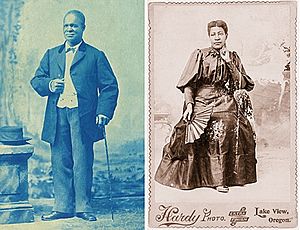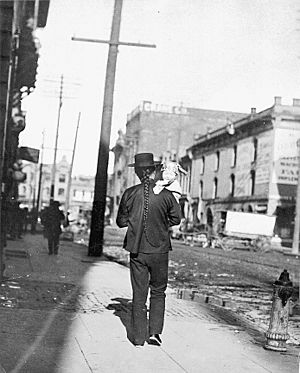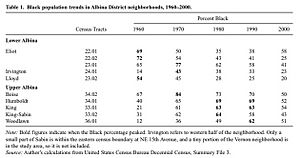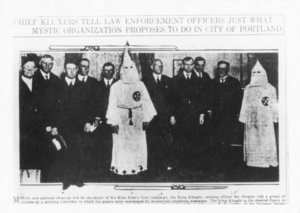Racism in Oregon facts for kids
The history of racism in Oregon started even before it became a U.S. state. When the Oregon Constitution was written in 1857, people talked a lot about race. In 1859, Oregon became the only state to join the United States with a law that kept black people out. The Willamette Valley was known for having white supremacist hate groups. People of African, Mexican, Hawaiian, and Asian backgrounds often faced unfair treatment and were kept separate. Portland, the biggest city in Oregon, still has one of the highest numbers of white residents compared to other major U.S. cities.
Contents
Oregon's History of Racism
Early Black Settlers in Oregon
The first known person of African descent to arrive in Oregon was a sailor named Markus Lopeus in 1788. He came with Captain Robert Gray. Lopeus later died in a fight with local Native Americans. In the years that followed, black fur trappers and explorers also settled in Oregon.
York, an enslaved man, was the only African American on the famous Lewis and Clark Expedition. This expedition reached Oregon in 1805.
Black Exclusion Laws and Chinese Immigration: 1844–1859
Two events led to Oregon's first Black Exclusion Law in 1844. The first was the Cockstock Affair. This happened when a black settler named James Saules reported that a Native American, Cockstock, had stolen his horse. White settlers tried to arrest Cockstock, but they faced a much larger group of Native Americans. The problem was solved, but it made white settlers afraid of the Native population.
The second event was the Saules-Pickett Dispute. Again, James Saules was involved. A man named Pickett accused Saules of attacking him and threatening to get Native Americans to fight against him. Other people also claimed Saules threatened them. Even though there was no proof, Saules was found guilty by a jury of Pickett's friends.
Peter Burnett used these events to propose a new law. He said it was to stop slavery in Oregon. However, he really wanted to keep black people from settling there at all. He feared they would join with Native Americans against white settlers. So, in June 1844, Oregon passed an Exclusion Law. This law banned black people from living in Oregon. If someone broke this law, they could be whipped or forced to work. In 1844, the government also banned slavery.
Another unfair law was made in 1849. This law stopped black people who were not already in the area from entering or living in the Oregon territory. In 1851, a black businessman named Jacob Vanderpool was arrested and forced to leave Oregon for breaking these laws.
In 1855, mixed-race men were not allowed to become citizens. In 1857, even though slavery was illegal, a bill was proposed to protect slave owners' property. It didn't pass because it seemed to give special rights to slave owners. That same year, a new law stopped black people from owning property in the state. In 1850, the first Chinese immigrants arrived, and more came in the following years.
In 1859, Oregon became the only state to join the U.S. with a black exclusion law. A new law that year also stopped black people from owning property and making contracts. These laws were rarely enforced, but they helped make Oregon a mostly white state. The exclusion laws stayed until 1926. In 2001, a measure was introduced to remove old, offensive words from the constitution. It was voted down in 2002 but later passed.
The Oregon government and the people who wrote the constitution used the excuse of preventing slavery to hide their real goals. They were not against slavery; they were white supremacists. They wanted to create a state just for white people. Their goal was to remove people of color, and their laws had lasting effects.
Anti-Chinese Laws and Violence: 1862–1920s
A newspaper article in the Daily Oregonian said that Chinese people were a problem and were "polluting" parts of the city. Similar comments were made about Chinese residents in Baker City. In 1862, all Black, Chinese, Hawaiian, and Mulatto people had to pay a $5 tax. If they didn't pay, the state could force them to work on roads for very little money.
The same year, interracial marriage between black and white people was made illegal. This law specifically said white people could not marry anyone who was one-fourth black or more. Later, this rule was extended to include Chinese and Hawaiian people (one-fourth or more) and Native Americans (half or more).
In 1868, the Fourteenth Amendment to the U.S. Constitution was passed. This amendment gave citizenship to black people. Oregon first approved it in 1866 but then took back its approval in 1868. Oregon finally approved it in 1973. In 1870, the Fifteenth Amendment was passed. This amendment stopped states from denying people the right to vote based on race. Oregon was one of eight states to reject it. That same year, federal law made a part of the Oregon State Constitution that banned black voting invalid. Oregon did not approve the Fifteenth Amendment until 1959.
From 1870 to 1885, anti-Chinese feelings grew in Oregon. Labor and political leaders wanted to force Chinese residents out and stop more from coming. In May 1873, the Portland city council tried to stop contractors from hiring Chinese workers. In August of that year, a fire at a Chinese laundry was possibly started by white people who wanted to remove the Chinese population. By 1880, most Chinese men lived in a very segregated area near Second and Oak Streets.
In the mid-1880s, two buildings in Portland's Chinatown burned down. Chinese woodcutter camps were also attacked by masked men. Rallies supporting anti-Chinese groups also took place. In 1883, an attempt to remove the ban on black voting failed, even though the Fifteenth Amendment already made it invalid. More attempts to remove the ban were made until it was finally removed in 1927.
In 1885, racial tensions got worse when about 500 Chinese residents were forced out of Tacoma, Washington, and sent to Portland. On February 22, 1886, a vote was held on removing Chinese residents from Portland. Later that day, a Chinese camp was attacked, and 100 to 200 Chinese workers were driven out. Even though the state constitution banned Chinese people from mining, some still did. The next year, a group of white men killed 34 Chinese miners in a massacre.
By 1890, 1,000 black people lived in Oregon, and this number doubled by 1920. In 1893, white citizens in La Grande burned down the city's Chinatown. This forced many Chinese residents to leave Oregon. Some stayed and tried to fight back but were also forced to leave. Around this time, "sundown towns" started to appear. These were towns where non-white people were not allowed after dark.
From 1900 to 1940, the Chinese population in Oregon decreased because of laws like the Page Act of 1875 and the Chinese Exclusion Act of 1882. These laws made Chinese communities isolated and discriminated against in housing, jobs, education, and health services.
In 1906, a court case called Taylor v. Cohn allowed white Americans to refuse service to black people in theaters. In 1918, black soldiers from California saw a sign that said, "We employ white help and cater to white trade only." The angry soldiers destroyed the sign. A similar event happened in 1943. In the early 1900s, black railroad workers who came to Portland faced extreme segregation. In 1919, the Realty Board of Portland made rules that stopped realtors and bankers from selling homes or giving loans to minorities in white neighborhoods. A law making public discrimination illegal was proposed that year and passed in 1953.
"No Negros, Chinese, or Japanese shall own or occupy property in this neighborhood unless they are a worker or a servant."
In the 1920s, housing covenants became common. These were agreements that allowed communities to keep out certain ethnic and religious groups. These rules came after many years of housing discrimination. These covenants were made illegal by the federal Civil Rights Act of 1968.
World War II and Beyond: 1944–Present
During World War II, many African Americans moved to Portland for shipyard jobs. The black population grew from 2,565 in 1940 to 25,000 in 1944. With this growth, racism in private businesses and labor unions also increased. Union rules prevented black workers from doing skilled jobs. They were often limited to common labor.
After the war, racism continued for black residents. Many lost their jobs when white soldiers returned. Earl Riley, the mayor of Portland, even told black residents they were not welcome. In response, groups like the National Association for the Advancement of Colored People (NAACP) and the Urban League started to protest and fight for equality.

In 1951, the law against interracial marriages and extra insurance fees for non-white drivers were removed. By the early 1960s, black people in Portland were not allowed to eat at white restaurants, use city swimming pools, or skate in ice rinks, except for one day set aside for them. In the 1970s, police killed several black men in Portland. In the 1980s, the Portland Police Bureau was investigated after officers put dead animals in front of black-owned restaurants.
In 1981, two Portland police officers put dead opossums outside a black-owned restaurant. The officers were fired but later got their jobs back. The FBI investigated but did not press charges. The police paid part of a settlement. This incident led to the creation of the Portland Internal Investigations Auditing Committee (PIIAC) in 1982, which voters approved.
In 1985, two Portland police officers who had been caught giving out T-shirts with a racist slogan were also reinstated after being fired.
In the 1980s and 1990s, neo-Nazi skinheads protested in the streets. On November 13, 1988, an Ethiopian student named Mulugeta Seraw was killed by white supremacists. In the 1990s, Portland became known for the neo-Nazi group Volksfront. Another neo-Nazi group, White Aryan Resistance, also recruited members. A union organizer recalled that there were "300 Nazis in a city of 300,000." In 1993, a racist skinhead was killed by a member of Skinheads Against Racial Prejudice.
On November 5, 2002, 70% of Oregon voters chose to remove outdated and offensive language from the Oregon Constitution. In 2007, neo-Nazis tried to hold a skinhead festival in Portland. In 2011, an audit found that black and Latino renters were unfairly treated in the housing market in 64% of cases. This broke housing laws, but no action was taken against the landlords. A similar audit in 2009 found discrimination against black renters in other Oregon cities.
In 2017, a double murder was committed by a white supremacist. On August 17, 2019, a rally was held by white nationalist and neo-Nazi groups.
Albina Neighborhood
In May 1948, a flood destroyed Vanport, displacing its many residents, including over 6,300 black people. Since Albina was the only place where black people could buy a house, it became the main area for black residents. White citizens then saw Albina as a "blighted slum" that needed fixing.
In 1956, an arena was built, forcing over 476 residents, half of whom were black, to move. More black-owned properties were destroyed by the building of the Veterans Memorial Coliseum and Interstate 5 in 1960. A hospital expansion in 1972 also cleared out 300 homes and businesses.
In the 1970s and 1980s, redlining and discrimination by banks affected black residents, causing most to leave. This meant the area was ready for new investment. By 1988, many houses were empty, and the city was dealing with gang problems. White residents started buying homes and businesses, which increased racial tensions. Many black residents suffered because they could not afford the higher taxes. By 1999, black people in Albina owned 36% fewer homes than a decade earlier, while white people owned 43% more. The displacement of black citizens in Albina continued into the early 2000s.
People have resisted this displacement. For example, in 2014, a Trader Joe's store was planned, which might have caused more gentrification. The Portland African American Leadership Forum wrote a letter protesting its construction, and Trader Joe's eventually pulled out. Some conservative blogs said this act of resistance was racist against white people, but this view was criticized.
Ku Klux Klan in Oregon
In the 1920s, Oregon had the largest number of Ku Klux Klan (KKK) members per person in the United States. On August 2, 1921, KKK members met with Portland government officials. They discussed negative news about the KKK and claims that Klan members and city officials were working together. Fred L. Gifford, a former company superintendent, was at this meeting.
Gifford was the leader, or grand dragon, of the Oregon Ku Klux Klan from 1921 to 1924. His goal was to recruit new members and gain power in the government. He succeeded, bringing in thousands of members, including politicians like Kaspar K. Kubli, a state legislator. Gifford was even nominated for U.S. Senate but declined.
By 1921, Klan membership was growing steadily. They used racism against minorities (especially Chinese and Japanese), anti-Catholic feelings, and ideas about social morality to attract members. KKK member Walter M. Pierce was elected governor in 1922. Klan leaders claimed over 35,000 active members in 1923. By the mid-1920s, the KKK's presence began to fade, and most local groups were gone by the end of the 1930s.
Legacy and Modern Solutions
According to Matt Novak of Gizmodo, Oregon "today still exists as a white utopia in some respects." Because of "Nearly two centuries of exclusion, violence and intimidation," Portland is one of the whitest major cities in the United States. In 2019, the population was almost 87% white (or 75% if you don't count Hispanic or Latino people). In 2016, about 38,000 African Americans lived in Portland, but over 10,000 of them had to move to the outskirts due to gentrification. In Portland, the gentrification of the historically black neighborhood Albina has caused problems between long-time black residents and new white residents.
A 2014 report found that black families in Portland were far behind white families in jobs, health, and high school graduation rates. In 2010, only 32% of African Americans in Multnomah County owned houses. This was much lower than the national average for African Americans and white Americans in the same county. Also that year, almost two-thirds of black single mothers with young children in Multnomah County lived in poverty. This was higher than the national average. The report concluded that "Oregon has been slow to dismantle overtly racist policies." As a result, African Americans in Multnomah County suffer from the lasting effects of these policies. African Americans in Portland were also more likely to be victims of crime and make up a large part of the jail population. Black children in Portland were also expelled from school the most, even starting from Kindergarten. Native American children were next highest.
While Oregon had clear racist laws, these laws were similar to those found elsewhere in the nation.
Oregon is a useful case study for the rest of the nation because the only thing unique about Oregon is [it] was bold enough to write it down. The same policies, practices and ideologies that shaped Oregon, shaped the nation as a whole.
Walidah Imarisha also said that racist practices from the past are "not only alive" but are "the foundation for the institutions of Oregon." She also commented that when she gives talks about the history of black residents in Oregon, Neo-Nazis often harass her with "explicit comments" and death threats.
To fight racism in Oregon, actions like police reform have been suggested. Governor Kate Brown has passed reforms for young people in the justice system. She has also worked to reduce harsh prison sentences and invest in crime prevention. In 2020, during the George Floyd protests, she met with Black organizers to discuss important social change. Brown plans to put into action reforms suggested by the People of Color Caucus.
A student named Greta Smith has started creating a database of racially restrictive housing covenants and a map of where people of color were excluded. Government officials have also allowed homeowners to ask for the removal of racist language in home agreements.
In 2012, to make up for those displaced by the expansion of Legacy Emanuel Hospital, several events were held. These included breakfasts and hearings for the former residents. That same year, an exhibit was created "to honor the neighborhood's history and accept the hospital's role in devastating it." The hospital also promised that such an act would never happen again. Some people, like Lolenzo Poe, criticized the hospital's actions as not being effective enough. However, others praised the hospital for being the first to admit the pain caused. To fix racial bias, Emanuel has also worked with minority contractors and hired minority workers to improve the "racial makeup" of its staff.
In 2017, CBSN showed a documentary film called Portland: Race Against the Past, which focused on racism in Portland.






